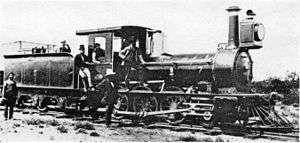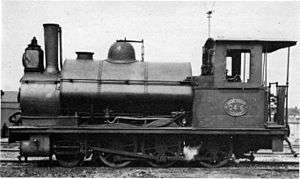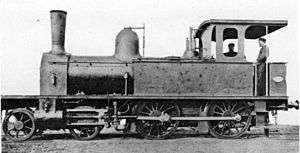1876 in South Africa
The following lists events that happened during 1876 in South Africa.
| |||||||||
| Decades: |
| ||||||||
|---|---|---|---|---|---|---|---|---|---|
| See also: | |||||||||
Incumbents
- Governor of the Cape of Good Hope and High Commissioner for Southern Africa: Henry Barkly.
- Lieutenant-governor of the Colony of Natal: Henry Ernest Gascoyne Bulwer.
- State President of the Orange Free State: Jan Brand.
- State President of the South African Republic: Thomas François Burgers.
- Lieutenant-Governor of Griqualand West: William Owen Lanyon.
- Prime Minister of the Cape of Good Hope: John Charles Molteno.
Events
- January
- The inaugural Champion Bat Tournament is held, a predecessor of first-class cricket in South Africa.
- 15 – Die Patriot, the first Afrikaans newspaper, begins to be published in Paarl.
- February
- 5 – The ship Memento sinks off East London and two 2nd Class 2-6-2TT locomotives intended for the Eastern System of the Cape Government Railways are lost.[1]
- March
- 27 – The Cape Times, the first daily newspaper in South Africa, begins in Cape Town, Cape Colony
- June
- July
- Construction begins on the Cape Town Central Station as hub to the Cape Government Railways.
- October
- 19 – The 2,700 ton steamer Windsor Castle sinks off Dassen Island.
- Unknown date
- A Dutch Reformed Church is built at what is now the town of Amersfoort in Mpumalanga Province.
- Prime Minister Molteno travels as plenipotentiary to London to discuss Britain's proposed confederation model for southern Africa.
- The "Molteno Unification Plan" is put forward as an alternative model for eventual political consolidation in southern Africa.[2]
- Isigidimi Sama Xhosa, the first Xhosa-run newspaper, is begun in Lovedale, Cape Colony.
- Britain admits wrongful action in its annexation of Griqualand West.
- President Johannes Brand of the Orange Free State rejects any discussion of Carnarvon's proposed confederation system for Southern Africa.
- The country's first official archives are created when the Cape Government appoints a commission to assemble, sort and index the records of the Cape.[3]
- Southern Africa's first railway tunnel, the Hex River tunnel on the railway line between Osplaas and Matroosberg, is completed.[4]
Births
- 9 October – Solomon Tshekisho Plaatje, intellectual, journalist, linguist, politician, translator, and writer, is born near Boshof, Orange Free State.
- 21 October – Sir Fraser Russell, Governor of Southern Rhodesia. (d. 1952)
Deaths
Railways
New lines
- Construction begins on the East London-King William's Town line.[5][6]
- In Natal construction begins on the Cape gauge railway line inland from Durban.[5]
Railway lines opened
- 1 January – Namaqualand – Kookfontein to O'okiep, 32 miles (51.5 kilometres).[7]
- 1 April – Cape Midland – Addo to Sand Flats, 22 miles 30 chains (36.0 kilometres).[8]
- 16 June – Cape Western – Ceres Road to Worcester, 24 miles 38 chains (39.4 kilometres).[8]
- 14 September – Cape Western – Bellville to Muldersvlei, 13 miles 37 chains (21.7 kilometres).[8]
- 18 December – Cape Eastern – East London to Breidbach, 38 miles 73 chains (62.6 kilometres).[8]
Locomotives
- Cape
Six new locomotive types enter service on the Cape Government Railways (CGR):
- The first ten of eighteen 1st Class 2-6-0 Mogul goods locomotives on the Western system.[1][9]:28–29[10]
- A pair of Stephenson's Patent back-to-back 2-6-0 Mogul type side-tank locomotives on the Cape Midland system.[1][11]:118–121
- The first of eight 2-6-0 Mogul tender locomotives on the Midland system, also designated 1st Class, all later rebuilt to saddle-tank shunting engines.[1][9]:28[11]:118–121
- A single experimental 0-6-0+0-6-0 Fairlie locomotive and a pair of 0-6-0 Stephenson's Patent permanently coupled back-to-back tank locomotives for comparative trials on the Eastern system. The Fairlie is the first articulated locomotive to enter service in South Africa.[9]:25–28, 31–32[12][13][14]
- The first of three 1st Class 0-4-0 saddle-tank locomotives with domed boilers on the Eastern System.[1][11]:118–119
- Natal
- In January the Natal Railway Company obtains its third and last 4 ft 8 1⁄2 in (1,435 mm) broad gauge locomotive, a side-tank engine named Perseverance.[9]:20–22
gollark: I meant using electromagnetic induction, obviously, not mathematical induction.
gollark: Prove it inductively.
gollark: Macron can't actually be made.
gollark: <@!435756251205468160> FOR OWNER
gollark: <@356107472269869058> `[ffmpeg] AVHWDeviceContext: Failed to query surface attributes: 20 (the requested function is not implemented).`
References
- C.G.R. Numbering Revised, Article by Dave Littley, SA Rail May–June 1993, pp. 94–95.
- Cana, Frank Richardson (1911). . In Chisholm, Hugh (ed.). Encyclopædia Britannica. 25 (11th ed.). Cambridge University Press. p. 475.
- http://www.westerncape.gov.za/your_gov/108#searching
- Lewis, Charles; Pivnic, Les. "Soul of A Railway". System 1, Part 3: Wellington to Touws River, pp. 31–32. (Retrieved on 3 September 2016)
- The South African Railways - Historical Survey. Editor George Hart, Publisher Bill Hart, Sponsored by Dorbyl Ltd., Published c. 1978.
- Statement Showing, in Chronological Order, the Date of Opening and the Mileage of Each Section of Railway, Statement No. 19, p. 181, ref. no. 200954-13
- Bagshawe, Peter (2012). Locomotives of the Namaqualand Railway and Copper Mines (1st ed.). Stenvalls. ISBN 978-91-7266-179-0.
- Report for year ending 31 December 1909, Cape Government Railways, Section VIII - Dates of Opening and the Length of the different Sections in the Cape Colony, from the Year 1873 to 31st December, 1909.
- Holland, D.F. (1971). Steam Locomotives of the South African Railways. 1: 1859–1910 (1st ed.). Newton Abbott, Devon: David & Charles. ISBN 978-0-7153-5382-0.
- Dulez, Jean A. (2012). Railways of Southern Africa 150 Years (Commemorating One Hundred and Fifty Years of Railways on the Sub-Continent – Complete Motive Power Classifications and Famous Trains – 1860–2011) (1st ed.). Garden View, Johannesburg, South Africa: Vidrail Productions. p. 36. ISBN 9 780620 512282.
- Holland, D. F. (1972). Steam Locomotives of the South African Railways. 2: 1910-1955 (1st ed.). Newton Abbott, Devon: David & Charles. ISBN 978-0-7153-5427-8.
- Dulez, Jean A. (2012). Railways of Southern Africa 150 Years (Commemorating One Hundred and Fifty Years of Railways on the Sub-Continent – Complete Motive Power Classifications and Famous Trains – 1860–2011) (1st ed.). Garden View, Johannesburg, South Africa: Vidrail Productions. pp. 21–22. ISBN 9 780620 512282.
- Abbott, Rowland A.S. (1970). The Fairlie Locomotive, (1st ed.). South Devon House, Newton Abbot, Devon: David & Charles, Newton Abbot. pp. 34, 36-38. ISBN 0 7153 4902 3.
- What were these, 2-6-0T or 0-6-0T?
This article is issued from Wikipedia. The text is licensed under Creative Commons - Attribution - Sharealike. Additional terms may apply for the media files.


.jpg)
